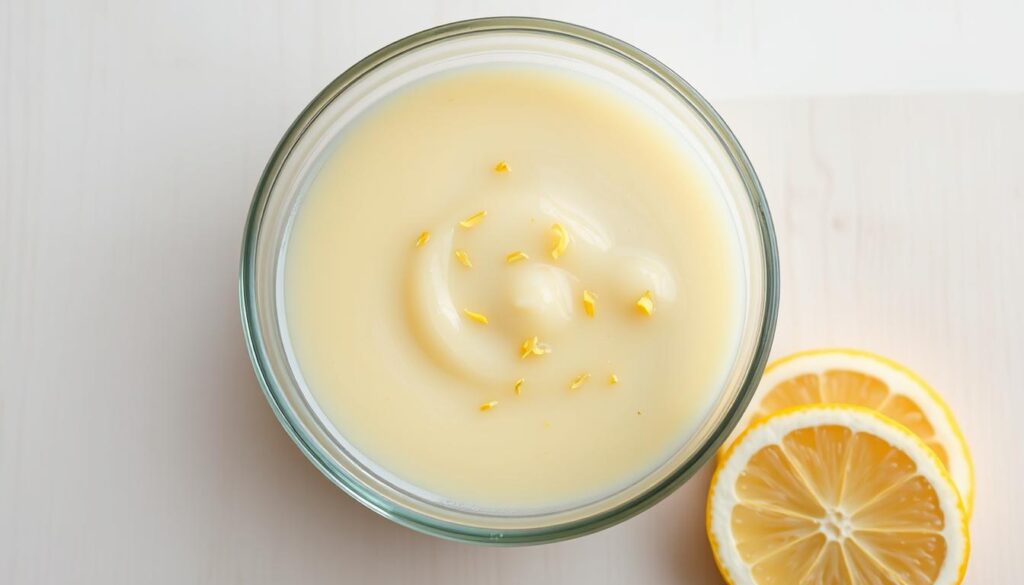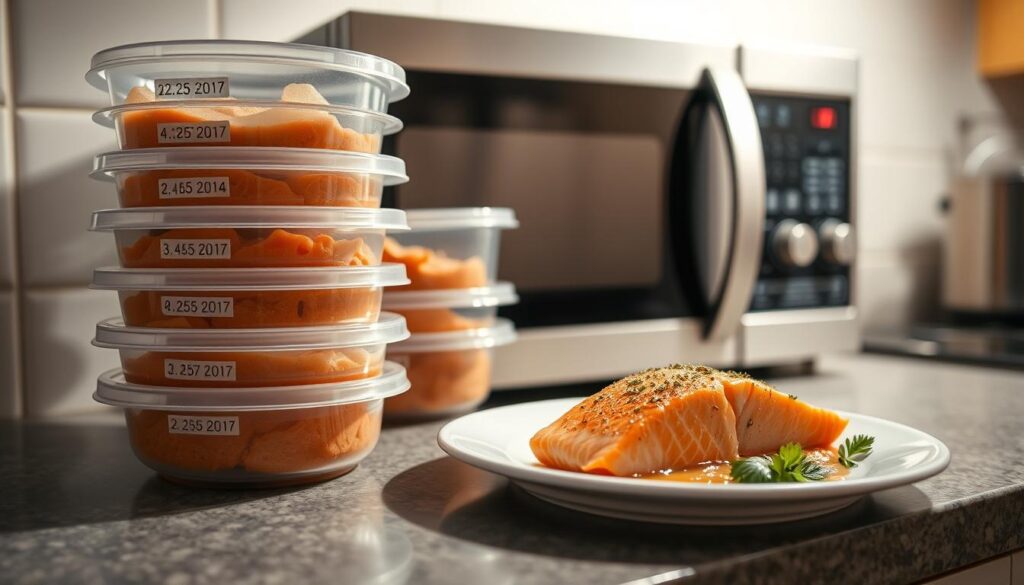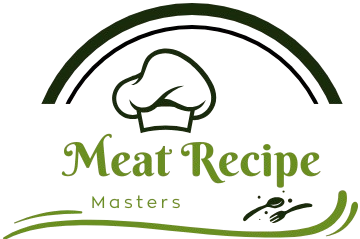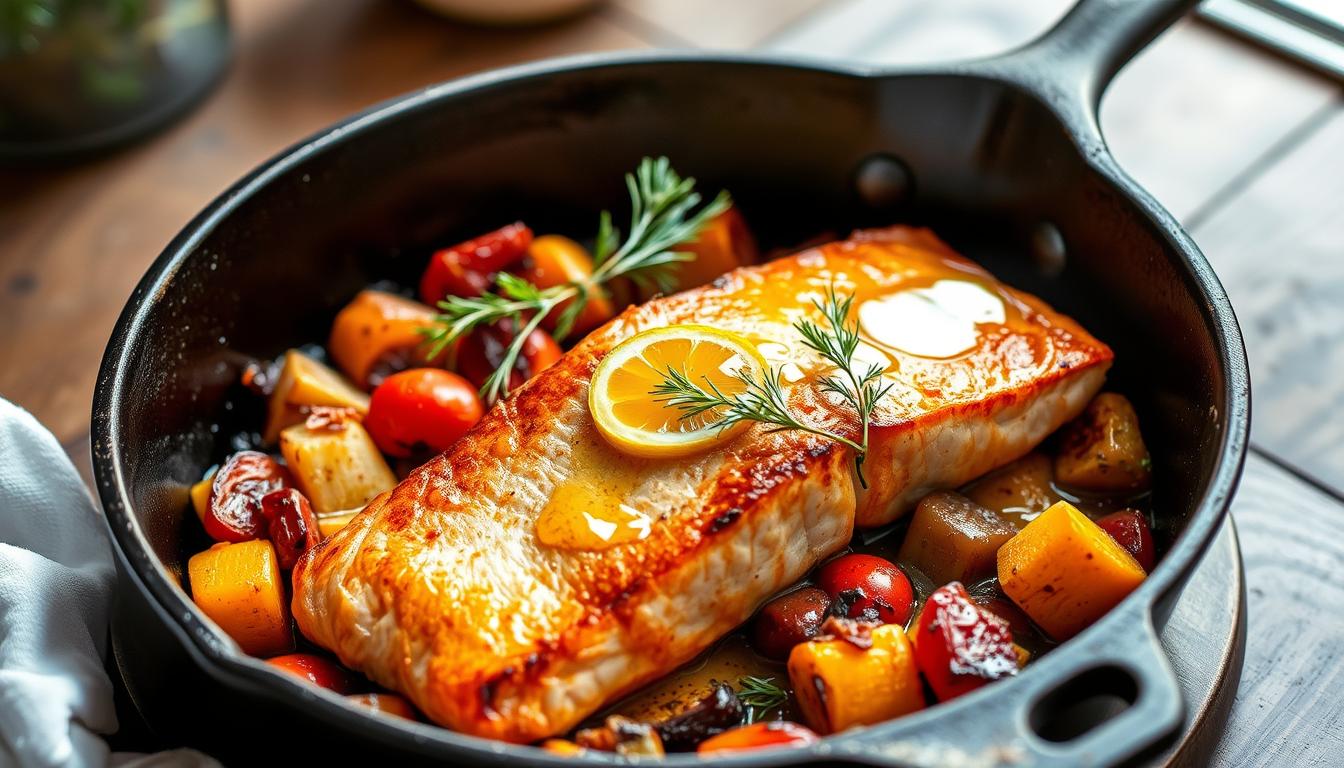The Best Cast Iron Salmon Dish
Every home cook dreams of making restaurant-quality meals at home. The cast iron salmon recipe is your secret to turning a simple weeknight dinner into a masterpiece. Imagine seared salmon with a golden crust, packed with flavor, ready in under 10 minutes.
Cooking salmon in a cast iron skillet is more than a method—it’s an art. It guarantees a perfect sear every time. The magic happens when high heat meets the cast iron’s incredible heat retention. This creates a caramelized exterior while keeping the inside tender and flaky.
Whether you’re a busy professional or a home cooking enthusiast, this cast iron salmon recipe is perfect for weeknights. It’s simple, quick, and delicious. It’s everything you want in a meal that looks like it came from a gourmet restaurant.
Table of Contents
Why Cast Iron Skillet Makes the Perfect Salmon
Cooking salmon needs precision and the right cookware. Cast iron skillets offer unique advantages that make your salmon preparation stand out. These versatile kitchen tools bring many benefits to your cooking.
Benefits of High-Heat Cooking
Cast iron skillets are best for high-heat cooking. They can get very hot and stay that way, perfect for cooking salmon. This high heat gives you a crispy outside and a tender inside.
- Rapid heat absorption
- Consistent temperature maintenance
- Quick searing capabilities
Even Heat Distribution Properties
Cast iron skillets cook salmon evenly. They spread heat all over, so your fish cooks the same everywhere. This means no cold spots and perfectly cooked salmon.
| Cookware Type | Heat Distribution | Salmon Cooking Quality |
|---|---|---|
| Stainless Steel | Uneven | Inconsistent |
| Cast Iron | Extremely Even | Perfect |
| Non-Stick Pan | Moderate | Fair |
Natural Non-Stick Surface Benefits
A well-seasoned cast iron skillet has a natural non-stick surface. This means your salmon comes out easily, looking great and easy to clean.
- No artificial non-stick chemicals
- Improved flavor retention
- Easy food release
Essential Ingredients for Perfect Cast Iron Salmon
Starting a delicious salmon dish means picking the right ingredients. Your journey begins with choosing the best salmon fillets and seasonings. These will make your cast iron cooking special.
Choosing the Right Salmon Cuts
Quality is key when cooking salmon. Wild salmon tastes better and is healthier than farmed. Look for these qualities:
- Fresh, vibrant-colored skin-on salmon fillets
- Firm texture without discoloration
- Consistent thickness for even cooking
Required Seasonings and Oils
The right seasonings can make your salmon amazing. Your essential ingredients are:
- High-quality olive oil
- Unsalted butter
- Freshly ground sea salt
- Cracked black pepper
- Fresh lemon
Optional Flavor Enhancers
Try different ingredients to make your salmon unique. Consider these:
- Fresh herbs: Dill, parsley, or thyme
- Garlic powder
- Red pepper flakes
- Smoked paprika
Pro tip: Pat your salmon dry before seasoning. This helps get a crispy, golden crust in your cast iron skillet.
How to Prepare Your Cast Iron Skillet
Getting your cast iron skillet ready is key to a great salmon dish. Seasoning cast iron is more than a cooking trick—it’s an art. It turns your cookware into a true culinary gem. A well-kept skillet ensures your salmon cooks evenly and gets a delicious golden crust.
- Seasoning the cast iron surface
- Heating the skillet to the right temperature
Seasoning cast iron creates a protective layer. It stops rust and gives a natural non-stick surface. Here’s how to do it:
- Clean your skillet with hot water
- Dry it completely to avoid rust
- Put a thin layer of oil that smokes well
- Bake the skillet upside down at 450°F for an hour
Heating the skillet right is key for a perfect sear. Warm it up slowly and evenly for the best cooking. Start with low heat, then go to medium-high before adding salmon.
| Skillet Preparation Stage | Temperature Range | Duration |
|---|---|---|
| Initial Heating | Low (250-300°F) | 3-4 minutes |
| Preheating | Medium-High (375-425°F) | 2-3 minutes |
| Cooking Temperature | High (425-450°F) | Immediate cooking |
Be patient when prepping your cast iron skillet. Spend time seasoning and heating. You’ll get a salmon dish that’s crispy outside and tender inside.
Step-by-Step Guide to Cast Iron Salmon
Cooking salmon in a cast iron skillet needs precision and skill. This guide will help you make a perfectly seared, delicious salmon dish. It will impress anyone who tries it.
Preparing Your Salmon
Before cooking, prepare your salmon for the best taste. Pat the salmon fillets dry with paper towels for a crispy outside. Season with salt and pepper to add flavor.
- Choose fresh, high-quality salmon fillets
- Pat fish completely dry
- Season with salt and pepper
- Bring salmon to room temperature before cooking
Mastering Salmon Cooking Time and Temperature
Getting the salmon just right is key. You want to cook it to 125-130°F for a moist, flaky texture.
| Cooking Stage | Duration | Heat Level |
|---|---|---|
| Initial Sear | 3 minutes | High heat |
| Flipping Salmon | 2 minutes | Medium heat |
Techniques for Flipping Salmon
Flipping salmon can be tricky. Use a thin, flexible spatula. Wait until the salmon naturally releases from the pan before flipping. This prevents sticking and keeps the fish’s texture.
Pro tip: Wait until the salmon naturally releases from the pan, which indicates it’s ready to be flipped. This prevents sticking and maintains the fish’s delicate texture.
Tips for Achieving the Perfect Sear
To get a restaurant-quality sear on salmon, you need precision and technique. Your aim is to get a crispy salmon skin and a beautiful caramelized crust. This will make your dish go from ordinary to extraordinary.
Begin by drying your salmon well with paper towels. Moisture is the enemy of a perfect sear. So, remove as much surface water as you can. This step is key to getting that crispy skin and golden-brown crust.
- Use a cast iron skillet for best heat retention
- Select high smoke point oils like avocado or grapeseed
- Ensure your pan is preheated to the right temperature
Patience is the key to a perfect sear. Let the salmon cook without moving it until it naturally releases from the pan. Don’t force the fish or try to move it too early. When it’s ready to flip, it will lift easily without sticking.
| Searing Technique | Key Considerations |
|---|---|
| Skin Side Down | Cook 70-80% of time to ensure crispy texture |
| Flesh Side Sear | Quick, high-heat finish for caramelized crust |
Look for visual cues like the edges turning opaque and the fish getting a golden-brown color. Your salmon should have a crispy outside and a tender, juicy inside.
Creating a Flavorful Lemon Butter Sauce
The perfect lemon butter sauce can take your cast iron salmon to the next level. It adds bright, rich flavors that enhance the salmon’s taste.

A great lemon butter sauce begins with the pan drippings from your seared salmon. These caramelized bits add incredible depth of flavor to your sauce.
Essential Ingredients
- 4 tablespoons unsalted butter
- 2 fresh lemons
- 2 cloves minced garlic
- Fresh parsley, chopped
- Salt and white pepper to taste
Sauce Preparation Method
- Remove salmon from the cast iron skillet, keeping pan drippings
- Reduce heat to medium-low
- Add butter to the pan, allowing it to melt slowly
- Squeeze fresh lemon juice into the pan
- Whisk in minced garlic
- Stir continuously until sauce becomes smooth
- Sprinkle chopped parsley for fresh flavor
Your homemade lemon butter sauce will make a restaurant-quality pan sauce. It perfectly complements the salmon’s crispy exterior. Drizzle it over the fish for a memorable meal.
Complementary Side Dishes
Choosing the right side dishes can make your cast iron salmon meal special. It’s all about finding flavors and textures that go well with the fish.
Your vegetable pairings should make the salmon taste even better without taking over. Here are some tasty choices:
- Roasted Asparagus: Crisp and tender, seasoned with garlic and lemon
- Quinoa Pilaf with Fresh Herbs
- Honey-Glazed Carrots
- Creamy Garlic Mashed Potatoes
For a light and refreshing side, try a crisp salad or grain-based dish. Carolina gold rice pilaf is great because it soaks up the salmon’s lemon butter sauce. Roasted cherry tomatoes add a sweet touch that goes well with the fish’s savory taste.
The best side dishes for salmon offer different textures and flavors. Mix crisp veggies, creamy dishes, and fresh ingredients for a balanced meal.
- Recommended Grain Options:
- Wild Rice Blend
- Couscous
- Farro
Pro tip: Cook your side dishes while the salmon is cooking. This way, everything is hot and ready to eat at the same time. It saves time and makes the meal more flavorful.
Storage and Reheating Guidelines
After cooking your cast iron salmon, it’s important to know how to store and reheat it. This ensures you enjoy your meal safely and keep its flavor. Storing it right is key to keeping your seafood fresh and tasty.

Leftover salmon needs careful handling for safety and taste. Here are some key tips for storing and reheating your cast iron salmon:
Refrigeration Storage Methods
- Cool the salmon completely before storing
- Use airtight containers to prevent moisture loss
- Store in the refrigerator within two hours of cooking
- Keep refrigerated salmon for 2-3 days maximum
Freezing Techniques
Freezing is a great way to keep your cooked salmon fresh longer. Follow these steps for successful storing cooked salmon:
- Allow salmon to cool to room temperature
- Wrap tightly in plastic wrap or aluminum foil
- Place in a freezer-safe container
- Label with the date of freezing
- Freeze for up to three months
Reheating Salmon Safely
When reheating salmon, use gentle heat to avoid drying it out. Here are some good methods:
| Reheating Method | Temperature | Cooking Time |
|---|---|---|
| Oven | 400°F (200°C) | 7-10 minutes |
| Stovetop | Medium-low heat | 3-5 minutes |
| Microwave | 50% power | 1-2 minutes |
Pro tip: Always check the salmon’s internal temperature reaches 145°F for safety. Don’t reheat it too many times, as it can lose texture and flavor.
Conclusion
Cooking salmon in a cast iron skillet makes any meal special. It’s not just about cooking; it’s about creating a memorable dining experience. By following the tips in this guide, you’ll become a pro at cooking at home.
This easy salmon recipe is just the beginning. Cast iron cooking is simple yet powerful. You’ll learn to make salmon that’s not only tasty but also perfectly cooked. You can try different flavors and sauces to keep your dishes exciting.
Start your cast iron cooking journey and see your kitchen skills grow. This method works for both beginners and seasoned cooks. Remember, the more you practice, the better you’ll get.
We encourage you to share your cast iron salmon stories and recipes. Your ideas can inspire others to try cast iron cooking. Get ready to wow your loved ones with your new cooking talents!
FAQ
What type of salmon works best for cast iron skillet cooking?
How do I prevent my salmon from sticking to the cast iron skillet?
What internal temperature indicates perfectly cooked salmon?
Can I cook frozen salmon directly in a cast iron skillet?
How long should I cook salmon in a cast iron skillet?
What are the best seasonings for cast iron salmon?
How do I clean and maintain my cast iron skillet after cooking salmon?
Can I make a sauce directly in the cast iron skillet after cooking salmon?
How long can I store leftover cooked salmon?
What are some quick side dishes that pair well with cast iron salmon?
There are no reviews yet. Be the first one to write one.

